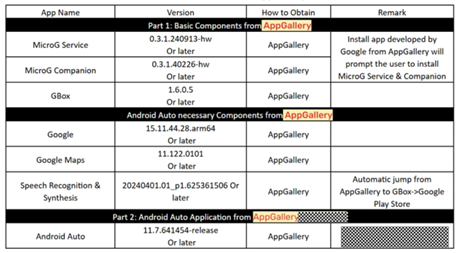04/12/2025 ,647 Views
Mobile apps succeed in 2026 by delivering clear value from the first tap. Users expect smooth flow, fast response, and reliable features that support their daily needs. Platforms like YouTube help sha...
Modern drivers juggle navigation, communication, and entertainment while keeping their focus on the road—a challenge Android Auto solves elegantly. This smart driving assistant transforms your car's display into a simplified, voice-controlled command center, minimizing distractions without sacrificing functionality. Whether you're checking traffic, sending hands-free messages, or queuing up your favorite playlist, Android Auto delivers essential features in a driver-friendly format. In this article, we'll explore Android Auto's top features and how they make every drive safer and more enjoyable.

1. Simplified & Safe Driving Interface
Clean Dashboard Layout
Android Auto prioritizes clarity with an uncluttered interface designed for quick glances. The home screen displays only the most relevant information—navigation directions, media controls, and upcoming calendar events—in large, easy-to-read cards. Unlike a smartphone screen filled with tiny icons, Android Auto’s layout ensures you won’t need to squint or scroll aimlessly while driving. The system automatically switches to night mode after sunset, reducing eye strain. Frequent actions like skipping songs or answering calls are placed within thumb’s reach, and the interface responds instantly to touches, thanks to the efficient processors.
Large, Driver-Friendly Icons
Buttons and menus are optimized for use on the move, with oversized icons and minimal text. For example, the music player shows album art prominently, and the call button takes up nearly a quarter of the screen when active. Voice command prompts appear in bold fonts, and navigation turns are highlighted in contrasting colors. Even the keyboard, when needed, uses a simplified layout with predictive text to minimize typing. If you’ve ever struggled with a car’s built-in infotainment system, Android Auto’s thoughtful design feels like a relief.
2. Smart Navigation & Real-Time Traffic
Android Auto’s navigation tools go beyond basic directions, offering real-time traffic updates, lane guidance, and even fuel-efficient route options. Google Maps and Waze integrate seamlessly, alerting you to accidents, speed traps, or road closures before you encounter them. Voice commands like “Hey Google, avoid tolls” or “Find the nearest gas station” work instantly, and the precise GPS ensures accurate location tracking even in dense urban areas. If you miss a turn, the system recalculates routes faster than most standalone GPS devices. Offline maps are available for areas with poor signal, and frequent destinations (like home or work) can be saved for one-tap access. For road trips, the “Explore” tab suggests nearby restaurants and attractions without requiring manual searches.
3. Voice Control & Google Assistant
The true power of Android Auto lies in its voice control, letting you keep both hands on the wheel while managing calls, messages, and navigation. A simple “Hey Google” wakes the assistant for natural-language requests like “Text Mom, I’ll be late” or “Play the latest podcast.” The assistant reads incoming messages aloud and lets you reply by voice, and it can add calendar reminders or to-do list items on the fly. For multilingual households, it supports multiple languages and accents. If you ask, “What’s my next turn?” it will repeat directions without making you look at the screen.
4. Entertainment & Media Options
Music & Podcast Apps
From Spotify to YouTube Music, Android Auto supports all major streaming services, with playback controls accessible from the home screen. Voice commands like “Play my workout playlist” or “Skip this song” eliminate fiddling with menus. Podcast fans can resume episodes where they left off, adjust playback speed, or browse recommendations by category. Curated “Driving Mixes” in apps like YouTube Music automatically queue upbeat tracks to keep you alert on long drives.
Audiobook Support
Apps like Audible and Google Play Books let you listen to audiobooks with chapter navigation and sleep timers. The system bookmarks your position automatically, so you never lose your place. For language learners, playback speed can be slowed down for clearer diction. Some audiobook apps even suggest titles based on your driving habits—for example, short-story collections for commuters or novels for road trips.
5. Smart Notifications & Communication
Android Auto filters out non-urgent notifications, displaying only calls, messages, and calendar alerts. When a message arrives, the assistant reads it aloud and waits for your voice reply, preventing the temptation to check your phone. Calls show the caller’s name and a large answer/decline button. For group chats, the assistant can read out messages sequentially and let you respond to each individually. Calendar reminders pop up at relevant times (e.g., “Leave now for your 3 PM meeting”), and you can join Zoom or Google Meet calls hands-free with a single tap.
6. Customization & App Support
Tailor Android Auto to your habits by rearranging the app launcher or enabling/disabling specific notifications. Third-party apps like WhatsApp, Telegram, and even fitness trackers can send concise alerts. The “Startup behavior” setting lets you choose whether Android Auto launches automatically when your phone connects. Developers are constantly adding new compatible apps, from parking assistants to EV charging station locators.

Conclusion
Android Auto isn’t just about convenience—it’s a safety tool that keeps your eyes on the road while staying connected. Features like voice-controlled navigation, smart notifications, and driver-optimized media playback turn stressful drives into smoother experiences. Huawei phones, with their robust performance, make the system even more responsive, though occasional huawei Android Auto not working glitches are easily resolved with updates or cable checks. Whether you’re a daily commuter or a weekend explorer, these features help you arrive safely and relaxed. Try them out on your next drive, and you’ll wonder how you ever managed without them.
04/12/2025 ,647 Views
Mobile apps succeed in 2026 by delivering clear value from the first tap. Users expect smooth flow, fast response, and reliable features that support their daily needs. Platforms like YouTube help sha...
Copyright © 2023 creativeconfessions.org. All rights reserved.
